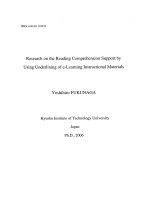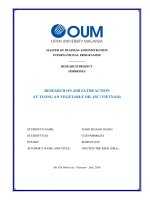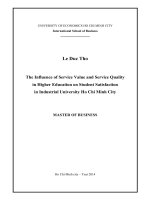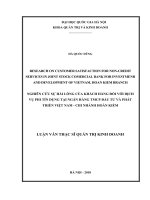Research on online learning, e learning impact on student satisfaction
Bạn đang xem bản rút gọn của tài liệu. Xem và tải ngay bản đầy đủ của tài liệu tại đây (1.59 MB, 40 trang )
<span class="text_page_counter">Trang 1</span><div class="page_container" data-page="1">
HO CHI MINH CITY UNIVERSITY OF TECHNOLOGY AND EDUCATION
FACULTY FOR HIGH QUALITY TRAININGCOURSE: DATA ANALYSIS INSTRUCTOR: Ph.D Nguyen Khac Hieu
RESEARCH ON ONLINE LEARNING, E-LEARNING IMPACT ON STUDENT SATISFACTION
Lê Hoàng Kim Thanh - 19124064 Nguyễn Mai Thảo - 19124065 Trần Thị Hải Yến - 19124043
1
</div><span class="text_page_counter">Trang 2</span><div class="page_container" data-page="2">SPECIAL THANKS TO
The first words allow the author to express sincere and deep gratitude to Ph.D. Nguyen Khac Hieu - the scientific instructor for the author, directed the topic, directly guided and had valuable suggestions to help the author during the research implementation.
The author would like to thank the teachers and teachers of Ho Chi Minh City University of Technology and Education for teaching and imparting valuable knowledge to the author as the foundation for this study.
At the same time, the author would like to thank the Masters and Postgraduate Department of Ho Chi Minh City University of Technical Education for their enthusiastic help and guidance in completing the procedures related to the study. assist.
The author also would like to sincerely thank you, sisters and colleagues for creating favorable conditions, providing documents, discussions to help the author complete the scales, surveys and take time to refer. and answer the survey.
Finally, the author would like to thank family and friends for their help and for creating a solid support for the author during the study and to obtain the research results.
Sincerely thank.
Ho Chi Minh City, June 2021 Authors
Lê Hoàng Kim Thanh
Nguyễn Mai Thảo
Trần Thị Hải Yến
</div><span class="text_page_counter">Trang 3</span><div class="page_container" data-page="3">1.6. Definitions of key concepts...7
1.6.1. Online learning, E-learning concepts:...7
1.6.2. Student satisfaction with training activities concept:...7
1.6.3 University service quality concept:...8
1.6.4 The relationship between university service quality and student satisfaction:...8
2. LITERATURE REVIEWS AND RESEARCH MODEL...9
</div><span class="text_page_counter">Trang 4</span><div class="page_container" data-page="4">3.3 Data collection and sample...26
3.4 Data analysis (Theory)...26
3.4.1 Descriptive:...26
3.4.2 Cronbach's Alpha analysis:...26
3.4.3 Exploratory factor analysis (EFA):...27
4.1.2 Descriptive statistics of variables:...31
4.2 Cronbach’s alpha analysis...32
4.2.1 APP (Non of Applications Factors):...32
4.2.2 TM (Non of Teaching Methods Factors):...33
4.4.3 SF (Non of System Functionality Factors):...33
4.4.4 SUPF (Non of Support Factors):...34
4.4.5 ITF (Non of Interaction in the learning process Factors):...34
4.4.6 SS (Non of Student Satisfaction):...34
4.4.7 INV (Non of The investment of your university):...35
4.3 Exploratory factor analysis (EFA):...35
5.2.2 About teaching methods:...40
5.2.3 About systems functionality:...41
5.2.4 About support services:...41
5.2.5 About interaction in the learning process:...41
5.2.6 About the investment of the university:...41
5.3 Limitations...41
REFERENCES...42
</div><span class="text_page_counter">Trang 6</span><div class="page_container" data-page="6">1. INTRODUCTION. 1.1 Reasons for choosing topics:
The year 2021 has been an eventful year with the most horrifying events - the Covid-19 pandemic is still ongoing. Having delayed the process of activities to all areas of the world, even students' attendance to school in classes is minimized. Online teaching method is applied instead. This is a method that has appeared for a long time but has not been invested nor used prevailing in previous years. Therefore, when teaching online has been introduced instead of traditional teaching methods, it has brought a lot of feedback from students - who are directly involved in acquiring knowledge through this learning method.
Ho Chi Minh City University of Technology and Education is no exception, the school has deployed and introduced this learning method and applied it urgently to students, in order to solve the difficult problem - the epidemic is impossible. to school in front of me. As well as to ensure the school's students' learning and continuing on with the pace.
Therefore, this survey aims to collect the most objective opinions from students of Ho Chi Minh City University of Technology and Education, as well as the satisfaction and actual learning results from the online teaching method. this is new. From that point out the shortcomings and shortcomings of online learning and new directional solutions to improve the quality and conditions of online teaching and learning of Ho Chi Minh City University of Technology and Education. Ho Chi Minh City, bringing student satisfaction, helps students have a learning condition and acquires knowledge through this learning in the most comfortable and effective way.
1.2 Research objectives. General objective:
Determine the factors affecting the student satisfaction of Ho Chi Minh City University of Technology and Education with the online instruction, E-Learning. Thereby proposal to upgrade and improve the online instruction, E-Learning.
Detailed objectives:
Identify the advantages, quality and influence of the Ho Chi Minh City University of Technology and Education’s online learning system.
Determine the importance and level of students' absorption of knowledge through online learning methods. Give some ideas, comments to improve the online learning system and
</div><span class="text_page_counter">Trang 7</span><div class="page_container" data-page="7">teaching efficiency on the online platform and bring satisfaction to students of Ho Chi Minh City University of Technology and Education about e-learning methods.
1.3 Research methods and data. 1.3.1 Research methods:
Quantitative research is done mainly by methods of online survey and mobile survey. The author relied on the results from studies with similar content to summarize the variables that affect student satisfaction when participating in online learning. Then put into a survey to get the opinion of students of Ho Chi Minh University of Technology and Education to synthesize the level of factors that create student satisfaction when studying online, and then propose solutions to improve and improve the quality of online teaching for students. Quantitative research is conducted as follows:
The author will design a survey based on variables of the same studies and the newly added variables.
The author put the link to participate in the survey on the student group of Ho Chi Minh City University of Technology and Education for students to participate in the survey to get opinions.
1.3.2 Data:
The data collection process is done according to a convenient method, the author performed in parallel during the study:
- Select students who are currently studying at Ho Chi Minh City University of Technology and Education.
- Send the survey to the subjects via the online form, link the survey form to the online discussion groups of students at Ho Chi Minh City University of Technology and Education on the social networking site Facebook.
- Recieve the survey via online survey, survey participants will be anonymous. - The author summarizes the survey questionnaires before conducting data entry and analysis.
1.4 Meanings of the research.
Helping the Ho Chi Minh City University of Technology and Education to offer suggestions for improving the complete online learning system to effectively absorb students'
knowledge, and propose measures to help students learn more effectively through the online learning system.
6
</div><span class="text_page_counter">Trang 8</span><div class="page_container" data-page="8">1.5 Structure of reports. Chapter 1: Introduction
Chapter 2: Literature reviews and research model Chapter 3: Research methods
Chapter 4: Research results
Chapter 5: Conclusions and suggestions, implications of research for Ho Chi Minh City University of Technology and Education to improve online teaching methods. 1.6. Definitions of key concepts.
1.6.1. Online learning, E-learning concepts:
Online learning or E-learning is a type of education and learning that uses the Internet as a medium. Lecturers and students can use the E-learning system on PCs, tablets, or cellphones with an Internet connection to learn and train. Teachers can use the E-learning platform to directly instruct students or send and save lectures and lesson data, including images, videos, and audio, on the system. Students can also see many lectures online or in person, interact with other teachers and students, establish discussion topics in the forum, take tests, and much more.
1.6.2. Student satisfaction with training activities concept:
There have been many conceptual studies on customer satisfaction, but these concepts are abstract and hazy because customer satisfaction is defined as meeting the requirements and wants of the consumer. Researchers have proposed the following consumer satisfaction concepts:
The "Perception – Perception" hypothesis, which is used to examine consumer satisfaction with the quality of an agency's services or products, is a prominent theory for measuring customer satisfaction. That idea is made up of two sub-processes that have independent effects on customer satisfaction: pre-purchase service expectations and post-purchase service perception. The total assessment of students' perceived value of training quality is based on their impression of what they gain and lose[ CITATION Trầ19 \l 1033 ]. Student satisfaction with training activities is defined as the students' satisfaction with their training and working environment (training programs, textbooks, learning materials, training organizations, staffs, etc.). lecturers, facilities, supporting equipment, support services, etc.) to meet the demand to become a skilled trainer. [ CITATION LêT14 \l 1033 ]
</div><span class="text_page_counter">Trang 9</span><div class="page_container" data-page="9">1.6.3 University service quality concept:
There are a lot of different viewpoints when it comes to educational services. Many individuals believe that education is a government-provided service. Private educational institutions, in fact, provide educational services. Higher education services are progressively becoming a known concept for many individuals in Vietnam nowadays. However, there are numerous points of view and disputes regarding higher education services in non-public colleges. Higher education is a service, a marketable commodity that is both collective (decided by the state and the general public) and marketable (determined by the market). In some elements, such as competition and monopoly, higher education is still subject to state involvement to some level. For a variety of reasons, higher education must be managed by the government. Most crucially, the key human resource for socioeconomic development is the result of higher education. However, some modern viewpoints hold that higher education services lack sufficient features to be termed a pure public benefit and instead possess several significant features of a private good. Customers in higher education are more aware of their wants than service suppliers. That is the ideal environment for the market mechanism in higher education to flourish.
1.6.4 The relationship between university service quality and student satisfaction: Education is one of the service sectors, and it is regarded as the backbone, contributing significantly to a country's development and economy. Universities in the country, as well as around the world, have a problem in terms of education quality (Ha Nam Khanh Giao, 2018). “Students, on the other hand, are a university's "clients" (Huang, 2009). “Service is one of the major components that enhance positive values and can affect the performance of a university,” Berry (1995) remarked. The perception of student happiness as a critical instrument for improving university service quality. “Higher education can be considered as a “pure service,” suggesting that it has all the distinct qualities of a service,” according to Oldfield & Baron (2000). As a result, “it is critical to attempt to analyze the degree of service quality and to understand the numerous aspects that affect total service quality, which is a factor for educational institutions to design their services in the best possible way,” according to the report (Firdaus, 2006).
8
</div><span class="text_page_counter">Trang 10</span><div class="page_container" data-page="10">2. LITERATURE REVIEWS AND RESEARCH MODEL. 2.1. Literature reviews.
E-learning is a type of service in which students will be involved in the service delivery process. In the field of human-machine interaction, the experience through the interactions affects their satisfaction. And after the experience process, the user will evaluate the difference between the original desire and the reality received and this difference is aggregated to create their satisfaction or dissatisfaction about the information system. Therefore, the process of assessing user satisfaction must be carried out before and after exposure to the system. In which there are some famous models such as a model of End-users computing statisfaction by Doll and Torkzadeh (1988).
Picture 2.1 Research Model “The Measurement of End-User Computing Satisfaction” Source: Doll and Torkzadeh (1988)
</div><span class="text_page_counter">Trang 11</span><div class="page_container" data-page="11">Picture 2.2 Research Model “The Measurement of End-User Computing Satisfaction” Source: Doll and Torkzadeh (1988)
In a traditional data processing environment (Figure 2.1), the user interacts with the computer indirectly through an analyst/programmer (Analyst/Programmer) or through operations (Operations). Periodic reports may be required from activities. For ad hoc or non-recurring requests an analyst/programmer helps the user. In this environment, users may not be aware of specific programs that are run to generate reports. In an end-user computing environment (Figure 2.2), decision makers interact directly with application software to enter information or prepare output reports. The environment includes a database, a base model, and an interactive software system that allows the user to interact directly with the computer system. Figures 2.1 and 2.2 do not depict all the differences between traditional and end-user computing environments. Other differences such as software, hardware, support requirements, and control procedures are not illustrated. Instead, the purpose of these figures is to illustrate that, in an end-user computing environment,
analysts/programmers and operations staff are not directly involved in supporting users, more responsible users for their own application.
The model is applied to perform measurement scales for customer satisfaction for online programs such as a research model on student satisfaction for e-learning..
10
</div><span class="text_page_counter">Trang 12</span><div class="page_container" data-page="12">Picture 2.1 Research Model “Investigation and integration of critical success factors for e-Learning learner satisfaction: A case of University of Economics and Law”
Source: Vu Thuy Hang and Nguyen Minh Tuan (2013)
2.2 Relevant research overview. 2.2.1 Domestic research:
(1) Vu Thuy Hang and Nguyen Manh Tuan (2013) researched “ Investigation and integration of critical success factors for e-Learning learner satisfaction: A case of University of Economics and Law”.
The research is mainly aimed at surveying the success factors of e-Learning from the student's perspective. In this study, the author chose the specific case of University of Economics and Law and conducted a survey of 40 students and alumni majoring in Management Information Systems on a series of ERP related subjects through analyzed using the Fuzzy AHP tool.
The result:
The result is ease of use, enthusiastic faculty with students, and up-to-date learning resources that make the most sense. These characteristics are installed into e-Learning and then student satisfaction is re-evaluated. Essential factors for success in e-Learning implementation are confirmed. But the author also asserts that the factors affecting the
</div><span class="text_page_counter">Trang 13</span><div class="page_container" data-page="13">success of e-Learning are necessary but not sufficient conditions for the success of that system in particular and of the information system in general.
(2) Bui Kien Trung (2016) researched “The relationship between training service quality and student satisfaction and loyalty in E-Learning distance learning”.
Research on the relationship between training service quality and student satisfaction and loyalty in DTTX-E is a highlight in the development of distance learning programs in Vietnam. Components of evaluating training service quality have a positive influence on satisfaction and an indirect influence on student loyalty in TTX-E. Student satisfaction is the satisfaction with the services provided by the program, student loyalty is measured through attitudinal loyalty (Perception-Emotion-Action).
The results:
The results of the study have shown that “training service quality is assessed by three main factors: quality of online information technology system, quality of teaching staff and quality of support services. positive relationship with satisfaction and loyalty of students in TTX-E.
Picture 2.3 Research Model “The relationship between training service quality and student satisfaction and loyalty in E-Learning distance learning”
Source: Bui Kien Trung (2016)
12
</div><span class="text_page_counter">Trang 14</span><div class="page_container" data-page="14">2.2.2 Research abroad:
(1) Rebecca A. Croxto (2014) researched “The Role of Interactivity in Student Satisfaction and Persistence in Online Learning.”
Online course enrollment is quickly growing, while attrition rates are still significant. The effect of interactivity in student happiness and persistence in online learning is examined in this paper. The empirical literature was analyzed via the lenses of Bandura's social cognition theory, Anderson's interaction equivalency theorem, and Tinto's social integration theory reviewed empirical literature.
The results:
Findings suggest that interactivity is an essential component of satisfaction and persistence for online learners and that preferences for online interactivity vary according to the type of student Student–instructor contact was also identified as a critical factor in student satisfaction and persistence among online students.
</div><span class="text_page_counter">Trang 15</span><div class="page_container" data-page="15">Picture 2.4 Research model of “The Role of Interactivity in Student Satisfaction and Persistence in Online Learning.”
(2) Michele T. Cole, Daniel J. Shelley, and Louis B. Swartz (2014). Researched “Online Instruction, E-Learning, and Student Satisfaction: A Three Year Study.”
This study was conducted over 3 years, on the satisfaction of graduate students and undergraduate students with online teaching at a university. Five hundred and fifty-three students participated in the study. Responses were consistent throughout, although some differences were noted in student satisfaction with their experience. There were no statistically significant differences in satisfaction levels based on gender, age or education level.
The results:
Despite the skepticism that online learning has been proven to be effective and at the same time save money (Bowen, 2013), online education seems to be here to stay. To date, there have been many studies on student satisfaction and student learning. There seems to be a consensus that both online and ambient tutorials are effective (Wagner, Garippo, & Lovaas, 2011). In Callaway's study (2012), researchers found, positive interactions, with instructors and with other students seem to go hand in hand with student satisfaction. Blended instruction is a way to foster interaction while providing convenience and the ability to learn at one's own pace.
(3) Lana C. Jackson, Ph.D., Stephanie J. Jones, Ed.D., Roy C. Rodriguez, Ph.D (2010) researched “Faculty actions that result in student satisfaction in Online courses.” This study identified faculty actions that positively influence student satisfaction in the online classroom at the community college level. Data were collected from student reviews of two web-based courses at two Texas community colleges.
The results:
The results of the study indicate that the actions of instructors in online courses seem to impact student satisfaction. Identifying the instructor actions that affect student satisfaction in online courses will greatly assist colleges and universities in enhancing their ability to provide an immersive experience quality online for their students.
(4) Cheok, Mei Lick; Wong, Su Luan (2015) researched “Predictors of E-Learning Satisfaction in Teaching and Learning for School Teachers: A Literature Review.”
14
</div><span class="text_page_counter">Trang 16</span><div class="page_container" data-page="16">This study is based on the evaluation of previous studies on satisfaction in using information technology systems. From there, building a theoretical model of the factors determining the satisfaction of e-learning in teaching and learning of junior high school teachers. There are three main defined groups: user-related characteristics, organizational characteristics, and e-learning system characteristics.
The results:
The results show that the teacher's characteristics such as attitude, anxiety and efficiency will to a large extent affect whether the system will operate effectively or not. Besides, teachers also need to be supported to change their pedagogy. Organization of support in terms of; training, techniques and management, are all important factors needed to motivate teachers to adopt innovation. The e-learning system is also very important in ensuring that teachers are satisfied after using it. Aspects such as flexibility, interactivity, perceived usefulness, and perceived ease of use must be considered.
(5) Yu-Chun Kuo, Andrew E. Walker, Brian R. Belland and Kerstin E. E. Schroder (2013) researched “A Predictive Study of Student Satisfaction in Online Education Programs”
This study has determined that learner-instructor interaction, learner-content interaction, and self-efficacy on the Internet are significant predictors of student satisfaction in online learning process. Learner interaction with content is the strongest predictor of any important predictor of student satisfaction. In addition, gender and class level significantly influence the interaction between learners and learners.
The results:
The results show that the interaction between learners and instructors, interaction between learners with content and their own effectiveness on the Internet are good predictors of student satisfaction while interacting. among students and self-regulated learning methods did not contribute to student satisfaction. Learner interaction and content explained the biggest difference in student satisfaction. In addition, gender, class level, and time spent online per week appear to influence learner-student interaction, Internet effectiveness, and self-regulation.
</div><span class="text_page_counter">Trang 17</span><div class="page_container" data-page="17">Table 2.1 Summary of relevant research results.
</div><span class="text_page_counter">Trang 19</span><div class="page_container" data-page="19">2.3 Research model.
Through the process of studying models from previous studies, the author found that there are many research problems about student satisfaction with E-learning. They almost only focus heavily on research on certain subjects, but forget about the complementary factors in creating student satisfaction in E-learning. There are some factors in the table that are similar to our factor in our model so we decided to group them together and as a result we have 7 factors affecting student satisfaction member for E-learning. The author has researched this issue through a survey of students in the University of Ho Chi Minh Technology and Education. So our research is one of those worth doing.
Along with that, summarizing the actual situation about online learning system in our university, we propose a research model on the factors affecting the student satisfaction of Ho Chi Minh City University of Technology and Education with the online instruction, E-Learning including 7 factors: (1) Applications, (2)The investment of the university, (3) Students Satisfaction, (4 ) Teaching methods, (5) System functionality, (6) Interaction in the learning process, (7) Support Services.
18
</div><span class="text_page_counter">Trang 20</span><div class="page_container" data-page="20">Picture 2.6. Proposed Research Model by The Authors
2.4 Research Hypotheses. 2.4.1 Applications:
As Online learning is applied in many courses, online learning applications are created and developed to meet the needs of lecturers and students. If an app is limited in meeting time will interrupt the teaching and learning process. In addition, the application quality is not good, the image is blurred, the sound is not clear is also a factor affecting student
</div>








